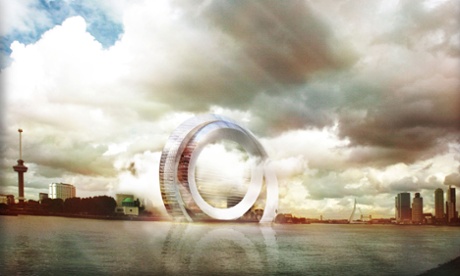
This week’s best city stories from around the web take us from an inhabitable wind turbine in Rotterdam to the streets of Detroit, where residents reflect on the city’s future. And for the tree nerds out there: wait until you see the atlas of all of New York City’s tree species.
We’d love to hear your responses to these stories and any others you’ve read recently, both at Guardian Cities and elsewhere: share your thoughts in the comments below.
Living is breezy
Over in Rotterdam, architects have designed a huge circular wind turbine ... that you can also live in. The Dutch Windwheel, as it’s called, uses electrostatic wind energy converter (EWICON) technology – and, perhaps crucially for any future residents, should be completely silent.
As CityMetric explains, the giant circular turbine will be surrounded by two rings: the outer serving as a tourist attraction ride of 40 “rotating cabins” on cables and the inner containing flats, a hotel and a restaurant. But is this sustainability-led architecture or simply a tourism-generating design gimmick?
An atlas of street trees
In case you didn’t know, there are approximately 592,130 trees in New York City. Inspired by this, Jill Hubley, a Brooklyn web developer, has made a colour-coded map of the city’s tree species using data from the 2005-06 Street Tree Census. As CityLab explains, the borough of Queens has the most species but Manhattan has the highest density. Brooklyn’s most popular tree is the London Plane, while Queens’ is the Norway maple and Manhattan’s the Honey locust. Also, the map looks nice.
Street corner campaigning
Earlier this month, some unusual posters appeared on street corners in London. As part of the Depaul UK “Nightstop” programme – in which volunteers offer homeless young people spare beds – the posters aim to shift stereotypical negative perceptions of homeless people. Placed on a corner, one side of the poster presents a familiar narrative which is then transformed by moving to the other side to see the whole message. “There’s another side to the story,” reads the tagline. The campaign hopes to expand to other cities around the UK.
Walking the city
Today in London marks the start of the Walking the City weekend, with walks exploring different aspects of the UK capital – from reflecting on gentrification on the Harrow Road or the changing landscape of King’s Cross to learning about the lives of migrants in Victorian-era Whitechapel. Ekua McMorris, who is leading the Harrow Road walk, explains that it involves “creating a bond” with the city through walking: “Our experience of the urban landscape changes when we become more conscious of it.”
Reimagining Detroit
The simultaneous decline and gentrification of Detroit is an issue we recently talked about. National Geographic’s new extensive interactive feature on the Motor City, Taking Back Detroit, aims to explore the relationships between the old and the new aspects of the city – and its evolving community. We hear thoughts from the residents of Detroit, explore the city’s neighbourhoods map by map and receive snippets of a virtual tour.
“Tough, real, and cheap, Detroit, with the nation’s largest municipal bankruptcy behind it, is suddenly attractive to investors, innovators, and would-be fixers, especially young adventurers,” writes Susan Ager. “The Detroiters I met, almost to a one, have faith in even an uncertain future. Indeed it’s what defines them.”

